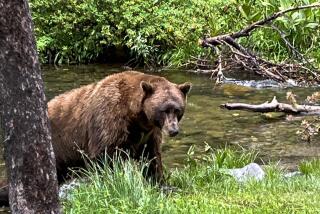Despite a Savage Crime, Campers Know O.C. Park as Peaceful Spot
- Share via
Until the young woman from Massachusetts was brutally assaulted, this had been her most recent home: 3,300 acres of oak and pine trees, mule deer and rattlesnakes, minutes from suburban Rancho Santa Margarita in south Orange County, where the average house is worth $600,000.
O’Neill Regional Park’s 86 camping spaces provide a temporary home for drifters and vacationers -- people from a few miles away or the other side of the continent. They are filled with families, RVs the size of houses and a smattering of transients who call their tents home.
One of the transients, the out-of-state 20-year-old woman, was beaten and left for dead in a pool of blood June 13, just a mile from the park entrance. A house painter who lives in Rancho Santa Margarita was arrested and charged with attempted murder, kidnapping and attempted rape.
The woman, who had been missing from Massachusetts since last year, had lived at O’Neill park for at least two weeks and was last seen there wearing a black tank top and paisley pajama pants, sheriff’s spokesman Jim Amormino said Monday. She remains in a medically induced coma, he said.
Most campground users said they were concerned about her, but only a few said the attack caused them to worry for their own safety.
“I had met that girl twice,” said Sandy Campbell, 49, sitting with a group of campers she and her husband had befriended. “I’m not as outgoing as she is, but I’m still a lot more careful now.”
Sheriff’s deputies, park rangers and campers say crime in the park -- especially something as violent as the attack nine days ago -- is unusual. The county-operated park, in shady Trabuco Canyon near Cleveland National Forest, is sought for its serenity, a place where quiet campfire conversations give way late at night to the howls of coyotes.
“You can leave your car doors open at night and the only things that go in there are squirrels,” said Theresa Alfonso, 23, who was camping on vacation with her father and son.
The Alfonsos had made friends with two other groups of campers, who were sitting under the shade of an oak, chatting while kids played in a tent. Most campers, though, seemed to stick to themselves, strangers just passing through and minding their own business.
Overnight stays at O’Neill cost $12. Visitors are allowed to spend a combined 15 days each month at O’Neill or Ronald W. Caspers Wilderness Park, northeast of San Juan Capistrano.
A small percentage of campers are essentially homeless, said John K. Bovee, supervising ranger at O’Neill park. Here, they lie low.
“These people don’t want to get kicked out,” Bovee said, looking up at a group of turkey vultures circling, wondering if a golden eagle was going to make its weekly appearance. “Where else are they going to stay? They’re one step from these streets.”
The few who make the park home cycle through the place for six to nine months, he said, then disappear. The park thins out in winter, when nighttime temperatures can drop into the 20s.
The one regular who returns year after year, Bovee said, is a reclusive older man in an ancient white station wagon filled to the brim with his belongings. Campers said he leaves during the day and returns late at night, seldom talking to anyone.
“He’s here every time we come,” said Bernola Webb of Bellflower. She and her 9-year-old daughter, Kandis Cline, come to the campground every year after school ends. They had been hiking in the hills when, spooked by the sound of wildlife, they scurried back to camp.
Webb’s boyfriend, Michael Reeves, sleeps in the back of his truck, enjoying the outdoors yet still close enough for his daily drive to his carpentry job in Costa Mesa.
Robert Sheely, a construction worker, has been staying in the park since Monday, homeless after his father sold their Santa Ana house two weeks ago. Sheely bought a $2,600 travel trailer and $5 tent, both used.
He drives to Santa Ana each day and returns to his blue tent at night, he said, to take pleasure in the park’s deep silence, punctuated by the sounds of wildlife.
“I enjoy the serenity of it all,” Sheely said. “You’re out in the woods and forget you’re so close to the city.”
There are characters among the park’s denizens, such as the fellow who boasted that he had been bitten on the arm last week by a rattlesnake. There were no visible signs of the encounter.
“I’ve been bitten 400 times,” the man said matter-of-factly. “I have natural anti-venin.”
Veteran RVer Bill Waugh arrived at the campground in his 35-foot motor home with satellite dish, towing a Jeep.
Waugh, 54, said he took to the road 20 years ago after watching his father die of cancer four months before his retirement -- which he had planned to spend in a bass boat and motor home.
Waugh decided he wouldn’t be robbed of that kind of experience. His RV is both full-time home and office, where he designs mobile surgery centers and stays in contact with the world using a wireless Internet connection. O’Neill park is a way station for him before he heads to Ohio for a veterans convention and to Michigan to visit a client.
If Waugh’s quarters are a mansion, nomads Ken and Sandy Campbell live in the equivalent of a studio apartment.
As with others, their home is a tent, where they bide their time before moving on. Ken, an auto body repairman, receives workers’ compensation, and Sandy is awaiting a traffic accident settlement. In a few days they’ll head to another campground.
Sandy Campbell said the campground is a better environment than the motels they have stayed in for the last 1 1/2years. In the motels, people used drugs and caused commotion.
Jim Halsey’s luxurious motor home makes Waugh’s 35-footer look like a compact. Behind it is a storage trailer large enough to accommodate a family.
Halsey, 45, simply parked his rig Thursday to hold the spot for the weekend, then returned to his Tustin home.
He had no qualms about leaving his RV behind, the assault notwithstanding.
“I used to come here when I was a little kid,” Halsey said. “There are genuinely good people here -- good, honest Americans.”
More to Read
Sign up for Essential California
The most important California stories and recommendations in your inbox every morning.
You may occasionally receive promotional content from the Los Angeles Times.











